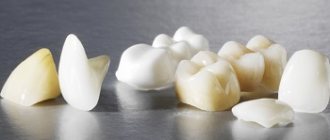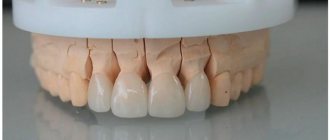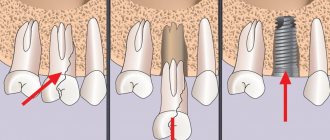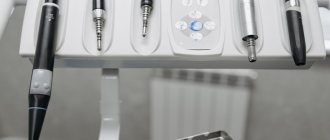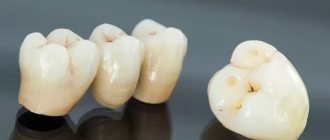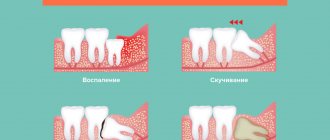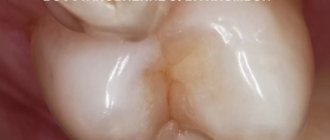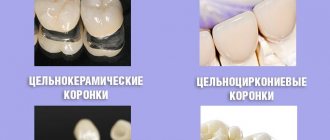- Materials
- Indications
- Contraindications
- Manufacturing and installation
- Advantages and disadvantages
- Care
- Life time
- Alternative Methods
- Advantages of the ROOTT Clinic
- Prices
- Work examples
- Doctors
- Reviews
- When to use:
any group of teeth - Material:
KHS, gold, silver, palladium - Installation time:
2 to 5 days - Features:
minimal tooth grinding, low price, short service life - Service life:
up to 3 years - Anesthesia:
local
Stamped dental crowns are the oldest in the family of single metal dentures. For a long time, stamping was the only method for manufacturing orthopedic systems. Today, such structures can confidently be called a relic of the past. Structurally, they do not differ from similar prostheses; they are made in the form of a steel cap, 0.2-0.3 mm
, which is fixed to the prepared dental unit.
The production of stamped crowns does not require complex technology. Dentures are created manually, from cylindrical metal caps - factory blanks, sleeves. The dental laboratory has steel sockets of different diameters and thicknesses. The technician selects a blank suitable in diameter and begins stamping the crown. Typically, prosthetic structures are gray or golden in color (depending on the material). At the request of the patient, the prosthesis is coated with gold, titanium nitrite, and lined with plastic or ceramic mass for better aesthetics.
What is a stamped metal crown?
Externally, the thin-walled structure resembles the shape of an incisor or molar
A stamped metal crown is an orthopedic prosthesis used in the dental industry to restore dentition.
Externally, the thin-walled structure resembles the shape of an incisor or molar.
This type of prosthetics is used when the root is preserved, and the indication is to partially restore the functionality of the tooth and prevent its further destruction.
The technology for making a prosthesis is the simplest: a shape is tapped from a blank-sleeve that is as close as possible to the impression made on the patient’s jaw.
The thickness of the crown wall depends on the metal used in the manufacturing process of the product. The average value is 0.2-0.3 mm, which determines the parameters for grinding the tooth.
Dental crowns: what are they?
Dental crowns are divided into types based on the material used. The most modern option would be crowns made of metal-free ceramics - zirconium dioxide or Emax glass ceramics (they will allow you to achieve the highest level of aesthetics). As for metal-ceramic crowns, their aesthetics may be no worse than ceramic ones, but in this case the price will be appropriate. But budget options for metal ceramics have very modest aesthetics.
But there are even more budget options: metal-plastic, as well as ordinary cast metal crowns. Speaking of how much a crown costs per tooth, the price will depend on the type of artificial crown, as well as the pricing policy of the dental clinic. The cost of a crown per tooth for 2022 in economy class and mid-price clinics will be (per 1 unit) –
- metal ceramics – from 10,000 to 20,000 rubles,
- ceramic crown “Emax” – on average 25,000 rubles,
- zirconium dioxide crown – from 30,000 to 40,000 rubles,
- all-metal - about 5,000 rubles.
Important: as you will see below, such a range in prices is dictated, as a rule, not by the greed of dental clinics, but by the fact that materials of different quality can be used in the manufacture of crowns, as well as less or more labor-intensive methods for their manufacture. For example, if you were offered metal ceramics for 8,000 or 10,000 rubles, then be sure that in this case the cheapest materials of Belarusian or Russian production will be used (24stoma.ru).
The use of cheap ceramic mass (porcelain) does not allow achieving acceptable aesthetics in the area of the front teeth, plus this is fraught with an increased risk of chipping the ceramics. Acceptable aesthetics of metal ceramics can be expected starting from 12,000 rubles, and good aesthetics – from 15,000 rubles for 1 Unit (i.e. 1 crown). In general, there are many subtle points on which the quality of your crowns will depend, and we will try to talk about all of this in detail below.
Clinical and laboratory stages of manufacturing
The process of making crowns requires adherence to certain principles to ensure high-quality installation and minimal likelihood of complications:
- Trying on a finished crown
The orthopedic structure must at least partially perform the function of a tooth.
- There should not be large gaps when the crown touches the neck of the tooth. A small gap is filled with cement, but during wear it gradually collapses. A large gap will cause a number of problems, but a small space is considered normal.
- The prosthesis is fixed in such a way that the metal surface does not sink into the gum groove by more than 0.3 mm. Exceeding this indicator causes the development of marginal periodontal disease.
- When installing a metal structure, it is necessary to maintain the interalveolar interval in relation to the adjacent tooth. Otherwise, injury to a healthy unit or soft tissue may occur.
- The shape of the prosthesis should be close to the anatomical one so that the appearance of a number of teeth is not disturbed and there is no discomfort when wearing the product.
The production of an orthopedic structure includes clinical and laboratory work.
The clinical stages are carried out by an orthopedist in the following sequence:
- The specialist grinds the tooth and creates a stump.
- The choice of color and type of material is made together with the patient.
- Taking impressions from the jaw where the prosthesis is planned to be installed.
- Transferring data to the laboratory technician, where the prosthesis is manufactured.
- Fitting and correction of orthopedic construction.
- Fixing the product with cement mortar.
Laboratory work is carried out by a dental technician.
The stamping technology is as follows:
- Modeling a prosthesis using an impression.
- Obtaining a plaster model.
- To identify the correct ratio of units in the dentition, the model is fixed in the occluder, giving it the position of central occlusion.
- The model is covered with wax and a crown is modeled.
- Making a stamp from a gypsum composition.
- Selection of a suitable sleeve (size, color).
- Stamping of light alloy crowns.
- Transfer the product to the orthopedist for fitting.
- If necessary, perform correction, as well as final grinding and polishing.
How are dentures made?
- Therapeutic treatment of the tooth is carried out after its preparation.
- An impression of both jaws is made using plaster or alginate. Plaster impressions are gradually becoming a thing of the past as obsolete; the use of alginate is preferable.
After this, the dentist begins to work closely in the dental laboratory.
- He is given a model of the dentition of both jaws cast in plaster, on which, in case of problems with the bite, the central relationship for its correction is determined.
- Plaster of Paris is placed in the occluder.
- A plaster stamp is cut out of the wax model that is then created, and then a metal one is made according to its sample.
- The sleeve-blank is selected as precisely as possible according to the size of the cast die.
The fact is that the sleeves are produced according to average parameters, and in order to fit the prepared stamp exactly to the tooth stump, there are two ways: choose the exact size or reduce it from the available ones. The sleeve is put on the second die and the fitting work begins, which includes thermal and mechanical effects on the workpiece.
The final check of the finished crown is done in the clinic, where, after fitting, they look at how tightly it fits (without taking into account the future cement layer) to the neck of the tooth. Defects are identified, then the outer surface is ground. If the patient expresses a desire, titanium nitride will be sprayed onto the steel surface.
At the last stage, the finished crown is dried using alcohol treatment, the cement is diluted and injected inside, and it is forcefully pressed onto the tooth stump. To do this, you just need to clench your jaw tightly. The squeezed out excess cement is removed.
Kinds
There are several types of metal structures:
- Dentures are installed in the presence of a destroyed tooth fragment, when it is not possible to install a filling or inlay
Stamped - made on the basis of caps (sleeves) with subsequent giving the workpiece the anatomical shape of the patient’s tooth;
- Cast - the manufacturing process includes casting molten metal into a prepared mold, this makes it possible to obtain precise parameters of the prosthesis and a high-strength product;
- Brazed - the manufacturing technology resembles a stamped one, but the sleeve is first cut into 2-3 parts, after tapping it is joined together by soldering (this method is used in cases where it is not possible to give an anatomical shape to the whole sleeve).
What materials are used
The material of stamped crowns must meet certain requirements - sufficient strength, safety for the body, resistance to oxidation, corrosion, ease of processing, low weight. Various metals and alloys are used:
- iron-based (stainless steel, chromium-nickel alloys);
- based on gold;
- based on silver and palladium.
There are several types of stamped structures:
- all-metal
- have a metallic color and shine; - combined
stamped crowns - the front metal wall of the structure is cut out and replaced with a plastic surface. Used for prosthetics of incisors, premolars; - with sputtering
- covering the crown with a thin layer of gold or titanium nitrite, which provides the prosthesis with a golden surface; - with lining
- a plastic or ceramic mass is applied to the finished cap, matched to the tone of the natural enamel.
The stamped crown with veneer is similar in appearance to natural teeth. If the supragingival part of 2-3 adjacent units is destroyed, a single structure is installed on each of them, without soldering into a bridge. The solder area is more susceptible to breakage under chewing stress. In addition, if 1 cap is damaged or deformed, the entire system will have to be removed.
Installation of stamped metal crowns
Fixation of crowns is carried out only after treatment of identified dental diseases. The prosthetic process involves tooth preparation, but the layer of bone tissue removed is minimal compared to other methods of restoring the dentition.
Preparatory work is carried out in the following sequence:
- Removing the top layer of enamel (0.3 mm). The work is performed with a special diamond disc.
- After preparation, the orthopedist checks the gaps between the causative and contacting teeth. The interval should correspond to the thickness of the crown. Control is carried out using a wax sheet.
- The next step is to prepare all contact surfaces (adjustment to the thickness of the crown).
- The process is completed by preparing the oral and vestibular parts of the tooth in order to give the stump a cylindrical shape. The diameters of the stump and neck of the tooth must be the same.
Installation of a crown made of stamped metal is carried out in the following order:
- examination by a doctor of the oral cavity to ensure the absence of inflammatory processes;
- quality control of preparatory work;
- fixing the crown to the stump by applying cement to the joint.
Upon completion of prosthetics, the doctor gives recommendations to the patient on caring for the oral cavity and, in particular, the crown.
Stages of crown installation
Contraindications
Relative
the procedure can be carried out with extreme caution
- Bite defects;
- increased abrasion of the enamel of the antagonist tooth;
- gum pathologies (atrophic, inflammatory);
- pregnancy;
- allergy to anesthetics;
- acute infections;
- mental disorders;
- exacerbation of a chronic disease.
Absolute
the procedure is strictly prohibited
- Severe periodontitis with tooth mobility grade III-IV;
- malignant processes of the oral cavity;
- allergy to prosthesis material;
- decompensated diabetes mellitus.
Advantages and disadvantages
When choosing the type of crown, it is necessary to compare the existing positive qualities, properties of the material and its disadvantages.
This will relieve discomfort and disappointment in the process of wearing an orthopedic design:
| Characteristics of a stamped metal crown | |
| pros | Minuses |
| Simple technology for making a crown. | Over time, the cement on which the structure sits deteriorates. This leads to the formation of gaps between the dentin and the prosthesis. |
| Possibility of using the structure without preliminary depulping. | The layer of stamped metal is insignificant, so while the crown is worn, its surfaces wear out. |
| The duration of the treatment process does not take much time. | This type of prosthetics does not restore the functionality of the tooth due to the inability to recreate the anatomical shape of a molar or incisor. |
| Low installation requirements, which allows the use of a stamped design even in cases where another type of prosthetics is contraindicated for a number of reasons. | Dentures made of stamped metal do not provide a tight fit to soft tissues, which provokes the penetration of food particles under the structure, where a favorable environment for caries and other diseases develops. |
| During the process of prosthetics, dental tissue is ground, but a minimal layer is removed (0.3 mm). | The aesthetic side of metal products leaves much to be desired. Such a jaw is unlikely to decorate a smile. |
| The use of a stamped metal product is the most affordable type of prosthetics. | |
There are plenty of pros and cons of a stamped prosthesis, but during the analysis it becomes clear that this type, due to its accessibility and simplicity of manufacturing technology, has the right to exist.
Advantages and disadvantages
- Pros: inexpensive, can be compared in price to the prices of plastic crowns and significantly outperform metal-ceramics, porcelain and others; ease of manufacture; preservation of a larger volume of living tissue, compared, for example, with porcelain crowns on the front teeth
- Disadvantages: due to the presence of uncoated metal, galvanosis may develop (the occurrence of current in the presence of different metals); poor aesthetics even if sprayed; frequent cases of caries under the crown due to loose fit or resorption of cement; rapid wear up to complete thinning due to the small thickness of the steel (about 0.3 mm); inability to qualitatively restore the anatomical shape (poor expression of tubercles and fissures)
Price
Prices for stamped dentures vary depending on the regional location of the clinic and the presence/absence of a sprayed layer
A wide selection of modern materials is gradually replacing the installation of stamped crowns from the list of services of some clinics.
But the presence of an interested segment of consumers still hinders the final refusal to use this material in prosthetics.
Prices for stamped dentures differ depending on the regional location of the clinic and the presence/absence of a sprayed layer.
The cost of a regular crown is 1,500 rubles. You will have to pay a little more for a product with spraying (1,700 rubles). In the case of making a crown with plastic lining, the price will increase to 2000 rubles.
Alternative Methods
Ceramic-composite metal-free, lightweight crowns with high light transmittance
Zirconium Durable crowns with high aesthetics, suitable for anterior and posterior teeth
Cast Durable and durable one-piece crowns made of metal alloys with the possibility of veneering
Article Expert
Shirokov Ivan Yurievich Dentist-orthopedist, doctor of the highest category
Work experience: more than 17 years
Features of care
Special care for crowns made from stamped metal is not required. The main measures include regular hygiene procedures and thorough cleaning of the oral cavity after eating food.
The list of recommended products includes:
- paste and brush with medium-hard bristles;
- rinse balm;
- dental floss.
After smoking cigarettes or drinking coffee, you need to rinse your mouth with a special liquid; in extreme cases, you can get by with water.
Every six months you need to visit the dental clinic to monitor the integrity of the prosthesis and for thorough cleaning of the oral cavity, which can only be provided by professional cleaning.
Such measures will help prevent the formation of plaque and the growth of stones. Also, based on a number of signs, a specialist can promptly identify the problem and prescribe treatment.
Implant supported crowns –
The cost of implant crowns depends on the choice of crown and abutment options. As a rule, the choice here is quite simple - 1) it is a metal-ceramic with a titanium abutment, 2) a zirconium crown, but it can be combined with both a zirconium dioxide abutment and a titanium abutment. The prices below are based on the use of a titanium abutment.
- Metal ceramics for an implant – from RUB 26,000.
- Zirconium dioxide crown – from RUB 35,000.
(the price is indicated together with the cost of the abutment and the use of the cement method of fixation, however, when using a screw type of fixation, the price will be higher in each case by approximately another 3,000 rubles). Prosthetics of 5-6-7 teeth on implants - before and after photos → Cost of installing different implants → Calculation of the cost of prosthetics on implants
Durability
Experts recommend not to wait for complications to arise and to consult a doctor promptly.
The metal alloy stamping is quite thin, so during the operation of the crown it wears out quickly.
The surface, which is often in contact with other teeth, is subject to abrasion.
This explains the short service life, which is indicated by 3-5 years.
Fragility is due to other factors:
- the presence of a gap between the structure and dentin, which provokes the development of caries and other dental problems;
- crown deformation as a result of eating hard foods.
Experts recommend not waiting for complications caused by the above reasons to occur.
Every 2-3 years, crowns simply need to be replaced with new ones, even if the old ones have not yet lost their aesthetic appearance. It is difficult to assess the condition of dentin under the structure, so there is a need for revision.
Combined crowns/bridges –
An example of one of the combinations of materials in the manufacture of crowns is metal-plastic (Fig. 14-15). They, like cast crowns, are made using a solid casting method from a cobalt-chrome alloy, but the front surface is subsequently additionally lined with white plastic. The price for metal-plastic crowns will be from 7,000 rubles per unit, and their advantages include acceptable aesthetics.
Disadvantages of metal-plastic crowns –
- Plastic in the oral cavity quickly loses its aesthetic properties, and over time, the white color of the plastic changes to gray. In addition, plastic tends to absorb liquid and swell slightly. This causes the plastic to begin to smell like unbrushed teeth over time.
- Metal-plastic crowns are also not very reliable: if the teeth are clenched tightly or while chewing, the plastic lining may simply fall out.
- Plastic is not very good for health (especially for allergy sufferers), because... there is always some amount of chemically active monomer remaining in it. The latter can be released for a very long time.
Combined bridges –
The metal frame of metal-ceramics and cast metal crowns are made according to the same principle - using the one-piece casting method. Therefore, different types of crowns can be combined in one bridge. For example, you need to make a bridge of 3 units (supported by teeth 5-7). In this case, the first 1-2 crowns falling into the smile line are made of metal-ceramic, and the distant crowns are made of solid casting (Fig. 16).
Dentists and dental technicians are not very fond of such designs, because... this reduces their cost. And if they tell you that this cannot be done, then this will only speak of the doctor’s personal reluctance. Moreover, such designs have other advantages (besides the price). For example, teeth for cast crowns require much less grinding than for metal-ceramic crowns, and therefore this design can last longer.
Indications for installation
Like any medical procedure, the installation of such prostheses must be carried out in accordance with the indications. This type of denture may be recommended in the following cases:
- as protection for supporting teeth in patients who are planning to have bridge prostheses installed;
- if there is damage in the crown part of the tooth to restore it as a functional unit;
- to protect a healthy tooth from external negative factors during the planned installation of a clasp denture.


